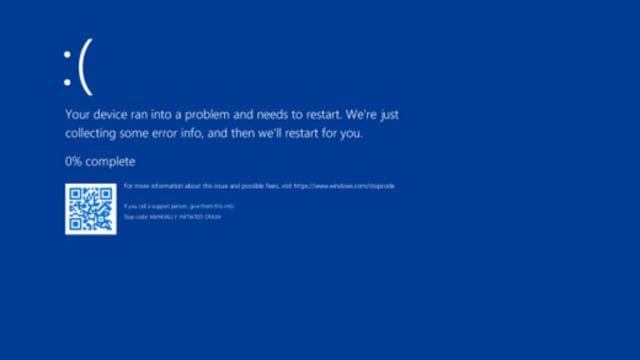Microsoft Windows systems down: What is the blue screen of death, why is it dreaded?
A variety of hardware and software issues can result in blue screen errors on Windows systems.
 The latest version of the Windows blue screen of death is not blue, it is reportedly cerulean. (Image Credit: Windows)
The latest version of the Windows blue screen of death is not blue, it is reportedly cerulean. (Image Credit: Windows)Microsoft’s IT systems were disrupted worldwide, with Windows PC failures being reported across services including airlines, banks, health services, emergency helplines, news channels, and more.
In the early hours of Friday, July 19, Microsoft published a post on X saying that it was “investigating an issue impacting users ability to access various Microsoft 365 apps and services.”
Soon, several users on X began sharing photos of their Windows desktops and laptops displaying an infamous and dreaded blue screen which typically indicates that the system has crashed and cannot continue to run.
Also here in Philippines pic.twitter.com/ZUnTqzk59r
— Capricorn (@el_capricious) July 19, 2024
While there is no clarity yet on what exactly caused the Microsoft outage and if the two incidents are linked, here’s all you need to know about the so-called ‘blue screen of death’ and what to do if it ever pops up on your system.
What is the blue screen of death?
The term blue screen of death gained popularity among internet users, whereas Microsoft typically refers to it as bugcheck or blue screen error.
A Windows device could display blue screen errors if the operating system has encountered a serious problem that has forced it to shut down or restart unexpectedly, according to Microsoft.
Usually, the crash screen has white text against a blue background and informs users that “Windows has been shut down to prevent damage to your computer” or something similar. In the case of Friday’s outage, the blue screen error said that Windows didn’t load correctly and directed users to either restart the system or troubleshoot the issue using advanced repair options.
Interestingly, the text displayed to users in the first-ever Windows blue screen was reportedly written by former Microsoft CEO Steve Ballmer. A variety of hardware and software issues can result in blue screen errors.
More specifically, blue screens are triggered when operating system code calls the KeBugCheck API which is equivalent to a fire alarm that is pressed as a last resort due to the lack of any other safe options, thus bringing the system to a premature halt. The blue screen tends to get pulled up before any memory has actually been corrupted, meaning that there is no data loss but ongoing work may not be retrievable.
How do you get rid of the blue screen of death?
The official resolution process to follow, according to Microsoft, is to shut down the system that is displaying the blue screen error, remove any newly installed hardware, and try restarting it. If that doesn’t work, users can try starting the system in Safe Mode which is a basic version of the Windows operating system, the company’s website states.
“You can also try getting the latest updates with Windows Update, help from other sources, or restoring Windows to an earlier point in time,” Microsoft recommends.
If the issue continues to persist, Microsoft suggests that users go to the Get Help app, type Troubleshoot BSOD error, and follow the instructions that come up. However, it must be noted that solutions to getting rid of the blue screen of death vary depending on the nature of the glitch.







